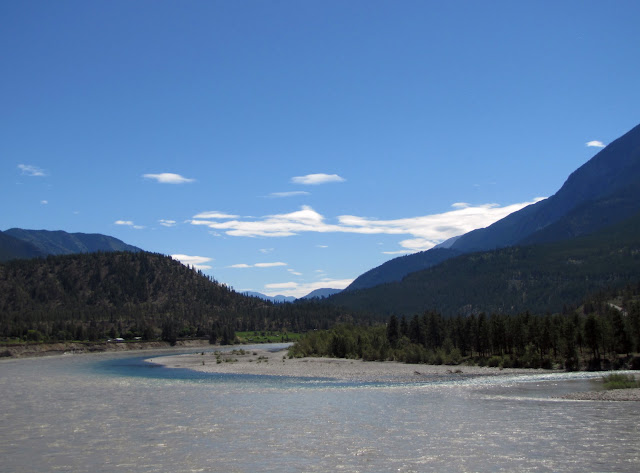The native peoples have lived and fished in this very spot for thousands of years.
Just down from our campsite was what is now called 'The Old Bridge'...a suspension bridge made of steel cables and wood...built in 1913 and no longer open to traffic.
We decided to go down and take a closer look in the morning...and spent some time watching the native fishery in action. The St'at'mic peoples have lived and fished at this very spot for thousands of years.
From what we observed...their methods have likely not changed a whole lot with the passing of time.
Papa pulled the fish from the river...cleaned them right there...and son pulled the salmon up the steep slope with a rope. From there he carried it into the fish-drying hut.
Inside the fish was being filleted and hung to dry. No one seemed in any particular rush...but the salmon were being hauled in one at a time.
While most were busy with the fish...someone nearby was drying apricots. Yum!
From our vantage point we could see four native fishing camps in action. While the salmon are in the river...they are camped along the bank...just as they have done for centuries.
We had intended to head home once we had inspected the Old Bridge but decided instead to head into town and check out Lillooet...one of the oldest communities in B.C.
During the Cariboo Gold Rush of the 1850's, Lillooet became a boom town. It is considered Mile 0...and all the road houses north of Lillooet were named for their distance from this marker. 100 Mile House is one hundred miles down the trail!
The Lillooet area was home to the first jade mines in B.C. B.C. is believed to have the largest deposits of jade in the world. A walk through town showcases pieces of art made of cut, polished and mounted jade.
We toured the Camels Barn and learned how camels had their place in the history of this town. In the early days of the gold rush, horses, mules and oxen were used to haul the heavy loads to the gold fields. One entrepreneur decided that camels would make better pack animals, and brought in 23 two-humped camels from Mongolia. His idea turned into a nightmare as the camels ate the miners clothing, kicked any and all who came near, and had their soft feet cut to ribbons on the treacherous roads. Soon most were abandoned and left to fend for themselves. A few were kept as curiosities...and the last one died on a farm in 1905.
We visited the museum...walked the 'golden mile of history'...and left town over the new bridge...aptly named The Bridge of the 23 Camels'.
Just out of town we came across a herd of mountain goats (or something of that nature)...but only one posed for me!
I was thinking the road was more suitable for goats than for motorhomes...about then! It was one-lane only for awhile...
...and we yielded to the oncoming bikes. The Fraser Canyon is a lovely drive...but not for those who are afraid of heights!
Though Lillooet is only a few hours away from home, it is the first time we have ever taken the time to explore. An interesting place it is!

















How often we do not explore the things closest to us. You've done very well and learned and shared so many interesting things. What a sad story about the camels. Poor critters. They were created for Mongolia I guess. There must be a lot of jewelry for sale there with all the jade. I have a piece of jade...a jade cross.
ReplyDeleteThanks for the history lesson! Neat pictures...the apricots looked pretty!
ReplyDeleteI love traveling that road through Lilloet...it is unique, quaint, and rustic. We've stopped there and just enjoyed the ambiance of the little town. I have similar photos but no photos of drying apricots. Looks like the way my mom used to do. Glad that you respected those cyclists.
ReplyDeleteGreat photos and info! And, here I thought jade came only from China!
ReplyDeleteI didn't know that fact about Lilloet's mile 0 and the reason for the name 100 Mile House. I'd love to have seen the fishing camp too!
ReplyDeleteHow interesting to watch the activity at the fishing camp. Like a step back in time. I haven't been to Lillooett for years - it is a little off the main road.
ReplyDeleteWhat a lovely blog, Judy. Excited to be your new follower.
ReplyDeleteHope you'll visit me too.
~betty
A wonderful history lesson for sure! Those dried apricots are calling to me.
ReplyDeleteLillooet looks like an interesting place to visit, Judy and you presented its history so well! The drying apricots reminded me of my Italian mohter-in-law --she dried figs,fruitsd and tomatoes this way! I wonder how dried salmon tastes?
ReplyDeleteWhat beautiful photos and historic information you provided in this post. I love learning about other cultures! Thank you so much for sharing your trip with us!
ReplyDeleteMary
I'm just asking myself if I have ever been to Lillooet. I must have been but not for a very long time. You have me wanting to take a road trip to see these sites. As always...you are our best in house travel expert of BC. I so enjoyed the photos of the fishing. We both did.
ReplyDeleteI like how you add humor, history, and beauty to your blog commentaries. I would like any place where salmon was being caught. Did you taste any of the fresh salmon? As for the camel story, I am still smiling. The jade mined there was most interesting, and the fact that you thought the road was better suited for goats than motorhomes would have been my exact thoughts too. Great post about Lillooet.
ReplyDelete